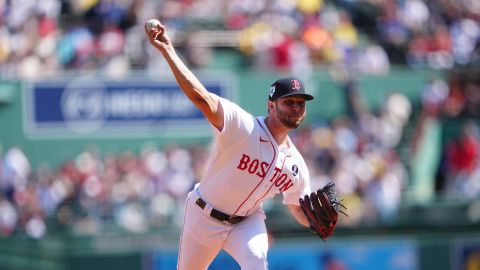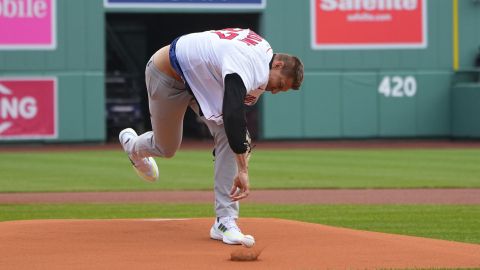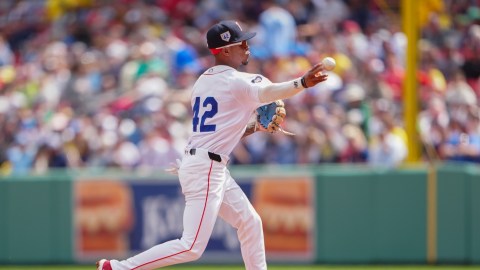What do Jacoby Ellsbury, Dustin Pedroia, Jon Lester and Jonathan Papelbon have in common? All four are products of the Red Sox farm system and were key contributors to the team's most recent world championship in 2007.
The team's next title may well be won thanks to the efforts of Clay Buchholz and Daniel Bard, or Boston's rapidly rising batch of top prospects — Lars Anderson, Casey Kelly, Jose Iglesias and Ryan Kalish.
Next week, Theo Epstein, Mike Hazen, Amiel Sawdaye and the rest of the front office will look to add to their already impressive stockpile of young talent in the 2010 MLB draft, which begins with the first round on Monday night.
The Red Sox have the 20th overall pick in the first round, gained from the Braves as compensation for Billy Wagner, who signed with Atlanta as a Type A free agent last winter. That's the earliest Boston has selected since 2003, when Epstein used the first selection of his career on outfielder David Murphy. (Murphy was later traded to Texas in the Eric Gagne deal and has evolved into a strong fourth outfielder.)
Moreover, Epstein and company will be on the clock four times in the draft's top 57 picks, each of those representing a chance to add a future star to the mix.
With the draft less than a week away, rumors about team's targets are predictably swirling. Here are five players who are expected to be on the Red Sox's radar.
Kolbrin Vitek, second baseman, Ball State University
The Red Sox have a history with Ball State standouts, having selected outfielder Jeremy Hazelbaker in the fourth round last year, and Vitek has opened plenty of eyes with a phenomenal junior campaign. He leads the team with a .361 average and 17 homers in 233 at-bats, fanning just 36 times all season. The concerns with the 21-year-old Vitek focus on whether he'll maintain his power after switching from an aluminum bat to a wooden one and what position he'll play professionally. In an ideal world, Vitek will blossom into an offense-first outfielder and perennial 20 homer-20 steal candidate.
Anthony Ranaudo, right-handed pitcher, Louisiana State University
Ranaudo is unquestionably one of the most talented and polished pitchers in this year's draft, but he recently experienced soreness in his elbow — the only reason he's likely to slip out of the top 10 picks. Nonetheless, he is a 6-foot-7, 230-pound junior with a mid-90s fastball and two offspeed pitches (a curveball and a changeup) that could potentially develop into elite offerings. If Ranaudo avoids the shelf, he is an ace in the making, but with medical information hard to come by, teams figure to tread with caution.
Stetson Allie, right-handed pitcher, St. Edward High School (Ohio)
A legitimate two-way prospect who can also play third base, Allie's most appealing tool is his arm — a veritable gun from the hot corner, and a 97-99-mph fastball-spewing cannon from the mound. The 19-year-old has excellent mechanics and a perfect 6-foot-4, 225-pound build, both of which have scouts drooling over his upside. But Allie is also extremely raw and will require significant development before his slider and changeup can be considered even average complementary offerings. The Red Sox may view Allie as the high school version of Daniel Bard.
Barret Loux, right-handed pitcher, Texas A&M University
If the Red Sox look for a more polished pitcher with a clean bill of health, their attention may turn to Loux, a 6-foot-5 junior who already has three usable pitches with outstanding command. As the ace of the Aggies' staff, Loux has posted a 2.53 ERA and fanned 126 batters in 96 innings of work this season. That has scouts dreaming of a Chris Carpenter or Dan Haren-like career for Loux, although he'll need to better harness his slider and curve to have a chance of attaining such heights.
Matt Harvey, right-handed pitcher, University of North Carolina
Another college arm with a sky-high ceiling, Harvey has been rumored as a possible top-15 pick, but is more likely to slip into the latter half of the first round because he won't be an easy player to sign. The 21-year-old has a mid-to-high 90-mph fastball with late tailing action, which he complements primarily with a sharp slider and 12-6 curve. Those two breaking pitches will need some refinement, but have flashed the potential to develop into bread-and-butter offerings. The most popular quibble with Harvey is that his mechanics have at times become inconsistent and led his control awry. Of course, arm angles and release points can be taught while talent cannot, and Harvey's tools are undeniable.
But the Red Sox's draft advantage ranges far beyond the first round.
With one of the largest amateur budgets in the league, the Red Sox are able to select the best players available deep into the draft. Epstein and Sawdaye wield the financial power to assuage talented high schoolers' exorbitant bonus demands and persuade them to give up scholarships to Stanford, Vanderbilt and other top schools for a chance to get on the fast track to The Show.
The Red Sox have followed precisely that plan to land the likes of Casey Kelly, Ryan Westmoreland and David Renfroe over the past few years and don't figure to deviate from it next week.
Peter Gammons said on Tuesday that the Red Sox might pursue local standout Kevin Ziomek, a southpaw from Amherst Regional High School (Mass.) who compensates for a lack of ideal velocity with craftiness and movement. Ziomek has a commitment to Vanderbilt, but might relinquish his spot on the Commodores' staff for a chance to pitch for his home-state squad.
Here are three other players with first round talent who could be swayed by a multi-million dollar signing bonus and a chance to pitch at Fenway.
Kyle Parker, outfielder, Clemson University
Parker is batting .364 with 19 homers in 206 at-bats for the Tigers this year, but it's unclear whether his heart lies with baseball. He has the potential to be a power-hitting right fielder, but also enjoyed tremendous success in his first season as the quarterback of Clemson's football team in 2009 and might prefer finding 25 receivers in the end zone to 25 fans in the stands. Parker's pop is sure to entice a team into calling his name in the early rounds, but it'll take some creativity to convince him to focus on baseball.
A.J. Vanegas, right handed pitcher, Redwood Christian High School (Calif.)
It won't be easy to steer Vanegas away from Stanford, but he has enough potential to make the gamble worthwhile. The 6-foot-3, 205 pounder hurls a fastball at 90-93 mph, and already sports a plus curveball and slider. That three pitch mix has the Cardinal excited about what he can do in the Pac-10, but it should also play well immediately in the minors. Vanegas is among the most polished high school arms available in the draft and would be a surefire first rounder if not for his desire to go to college.
Kaleb Cowart, shortstop and right handed pitcher, Cook County High School (Ga.)
The Red Sox have a history with two-way athletes — Kelly and Renfroe fit that mold — and Cowart is just that. He's a switch-hitting infielder with great bat speed, solid power potential, and one of the finest high school gloves available, but also owns a low-to-mid-90s fastball and a sharp curveball that has the makings of an A.J. Burnett-like weapon. Cowart is a top-40 talent regardless of how he's used, but will need to be talked out of a full-ride scholarship to Florida State.
All of those players and many others have the potential to eventually lead the Red Sox back to postseason glory. Be sure to follow the MLB Draft, which begins on Monday, June 7 at 7 p.m. Eastern, to find out who the newest additions to one of baseball's best farm systems will be.



